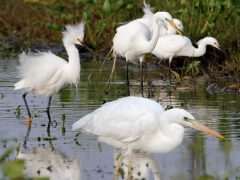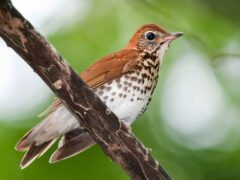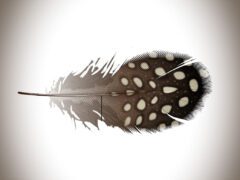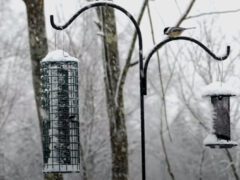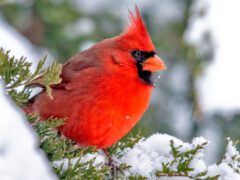Bushtit Similar Species Comparison
Main SpeciesBushtit
Male (Pacific)
Tiny, kinglet-sized birds. They are plump and large-headed, with a long tail and a short, stubby bill. Plain brown and gray overall, but plumage color varies geographically.
© Paul Fenwick / Macaulay LibraryCalifornia, October 07, 2020Male (Interior)
Tiny with a long tail and short bill. Individuals in the interior are paler gray and have gray crowns with tan cheeks while those closer to the coast have brown crowns.
© Darren Clark / Macaulay LibraryIdaho, March 13, 2017Male
Nervously flits around from branch to branch in the understory of oak forests, evergreen woodlands, dry scrublands, streamsides, and suburbs.
© Timothy Barksdale / Macaulay LibraryCalifornia, April 01, 1997Male (melanotis Group)
Males in southwest Texas southward through Mexico have black masks and females have brown masks. The mask color tends to get darker as one moves farther south.
© Anuar López / Macaulay LibraryEstado de México, February 23, 2019Female (Pacific)
Tiny bird that looks like a ping-pong ball with a long tail. Females have pale eyes while males and juveniles have dark eyes.
© DigiBirdTrek CA / Macaulay LibraryCalifornia, February 27, 2020Adult
Males and females help build a hanging socklike nest made from spider webs and plant material.
© Larry Arbanas / Macaulay LibraryArizona, May 01, 2006Female (Interior)
Individuals in the interior have grayer crowns and brown cheeks. Females have pale eyes while males and juveniles have dark eyes.
© Darren Clark / Macaulay LibraryIdaho, November 13, 2019Adult and juvenile
Parents feed fledglings for up to 2 weeks after they leave the nest.
© Larry Arbanas / Macaulay LibraryCalifornia, May 01, 2005Male (melanotis Group)
Females in southwest Texas southward through Mexico have brown masks while males have black masks, the color of which become darker as one heads farther south.
© Miguel Aguilar @birdnomad / Macaulay LibraryCiudad de México, April 11, 2018Male (Pacific)
Tiny, kinglet-sized bird with a long tail and short bill. Almost always on the move twittering as it goes. Birds along the coast have browner crowns.
© Matt Davis / Macaulay LibraryCalifornia, February 26, 2017Flock
Sprightly, social songbirds often seen in constantly twittering flocks.
© Alane Gray / Macaulay LibraryCalifornia, July 22, 2018Habitat
Found in open woods or scrubby areas, particularly pine-oak woodlands and chaparral, as well as suburbs and parks.
© Taylor Abbott / Macaulay LibraryUtah, May 06, 2017Similar SpeciesBlack-capped Chickadee
Adult
Black-capped Chickadees are slightly larger than Bushtits, and their characteristic dark crown, white face, and dark bib provide much more contrast than Bushtits show.
© Scott Martin / Macaulay LibraryMassachusetts, February 03, 2017Similar SpeciesMountain Chickadee
Adult
Mountain Chickadees are plumper than Bushtits with a white cheek patch that Bushtits lack.
© Craig Johnson / Macaulay LibraryIdaho, May 20, 2017Similar SpeciesChestnut-backed Chickadee
Adult
Chestnut-backed Chickadees have chestnut backs and sides unlike the plain grayish brown Bushtit.
© Neill Vanhinsberg / Macaulay LibraryBritish Columbia, March 25, 2017Similar SpeciesBlue-gray Gnatcatcher
Female/nonbreeding male
Gnatcatchers have longer bills and smaller heads than Bushtits. Their black tails contrast sharply with their duller gray-brown backs unlike Bushtits.
© Peter Hawrylyshyn / Macaulay LibraryCalifornia, June 09, 2017Similar SpeciesGolden-crowned Kinglet
Adult male
Golden-crowned Kinglets have olive upperparts and boldly marked heads, whereas Bushtits are rather plain-faced.
© Ryan Schain / Macaulay LibraryMassachusetts, December 05, 2016Similar SpeciesOak Titmouse
Adult/immature
Oak Titmice are larger than Bushtits with a distinct, short crest to the head.
© Ken Chamberlain / Macaulay LibraryOregon, March 14, 2017Similar SpeciesJuniper Titmouse
Adult/immature
Juniper Titmice have a crest unlike the round-headed Bushtit. They are also larger with a thicker bill than Bushtits.
© Taylor Abbott / Macaulay LibraryUtah, April 22, 2017Similar SpeciesVerdin
Adult
Verdins have a longer, sharper bill than Bushtits. They also have a yellow face and a small rufous patch in the wing that Verdins lack.
© Michael O'Brien / Macaulay LibraryBaja California Sur, March 07, 2009Compare with Similar Species
Click on an image to compare
Species in This Family
Long-tailed Tits(Order: Passeriformes, Family: Aegithalidae)
More to Read
Don't miss a thing! Join our email list
The Cornell Lab will send you updates about birds,
birding, and opportunities to help bird conservation.




